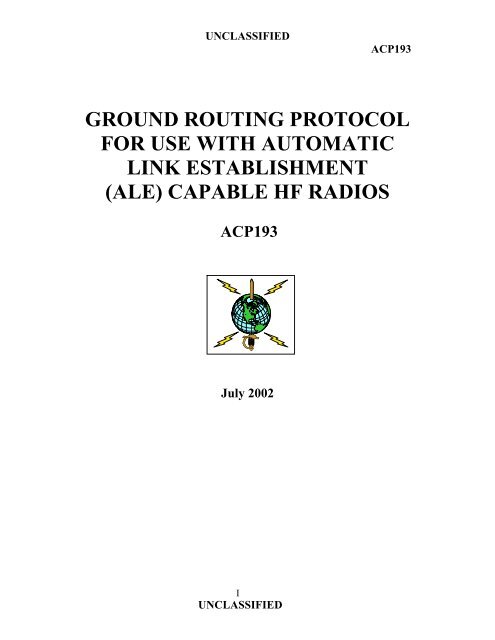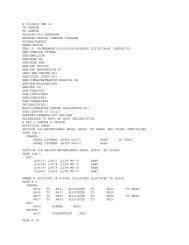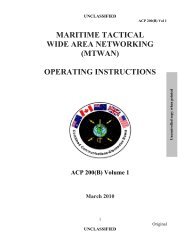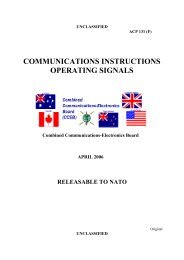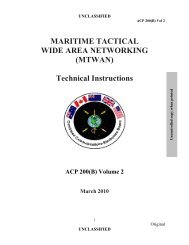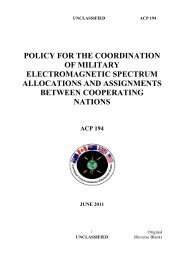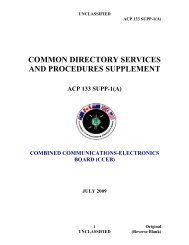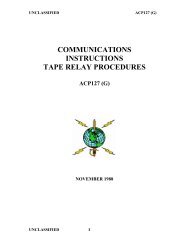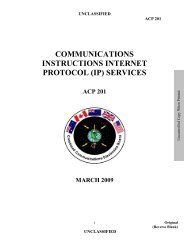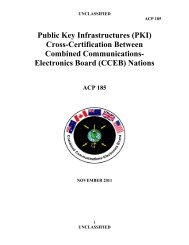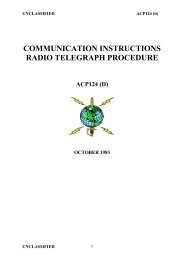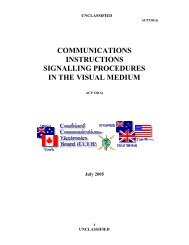ground routing protocol for use with automatic link establishment
ground routing protocol for use with automatic link establishment
ground routing protocol for use with automatic link establishment
You also want an ePaper? Increase the reach of your titles
YUMPU automatically turns print PDFs into web optimized ePapers that Google loves.
UNCLASSIFIED<br />
ACP193<br />
GROUND ROUTING PROTOCOL<br />
FOR USE WITH AUTOMATIC<br />
LINK ESTABLISHMENT<br />
(ALE) CAPABLE HF RADIOS<br />
ACP193<br />
July 2002<br />
I<br />
UNCLASSIFIED
UNCLASSIFIED<br />
ACP193<br />
FOREWORD<br />
July 2002<br />
1. The Combined Communications-Electronics Board (CCEB) is comprised of the five<br />
member nations, Australia, Canada, New Zealand, United Kingdom and United States and<br />
is the Sponsoring Authority <strong>for</strong> all Allied Communications Publications (ACPs). ACPs are<br />
raised and issued under common agreement between the member nations.<br />
2. ACP193, Ground Routing Protocol <strong>for</strong> <strong>use</strong> <strong>with</strong> Automatic Link Establishment (ALE)<br />
capable HF Radios, is an UNCLASSIFIED CCEB publication.<br />
3. This publication contains Allied military in<strong>for</strong>mation <strong>for</strong> official purposes only.<br />
4. It is permitted to copy or make extracts from this publication.<br />
5. This ACP is to be maintained and amended in accordance <strong>with</strong> the provisions of this<br />
document.<br />
II<br />
UNCLASSIFIED
UNCLASSIFIED<br />
ACP193<br />
CCEB LETTER OF PROMULGATION<br />
FOR ACP193<br />
1. The purpose of this Combined Communication Electronics Board (CCEB) Letter of<br />
Promulgation is to implement ACP193 <strong>with</strong>in the Armed Forces of the CCEB Nations.<br />
ACP 193, GROUND ROUTING PROTOCOL FOR USE WITH AUTOMATIC LINK<br />
ESTABLISHMENT (ALE) CAPABLE HF RADIOS, is an UNCLASSIFIED<br />
publication developed <strong>for</strong> Allied <strong>use</strong> and, under the direction of the CCEB Principals.<br />
It is promulgated <strong>for</strong> guidance, in<strong>for</strong>mation, and <strong>use</strong> by the Armed Forces and other<br />
<strong>use</strong>rs of military communications facilities.<br />
2. ACP193 is effective on receipt <strong>for</strong> CCEB Nations and when by the NATO Military<br />
Committee (NAMILCOM) <strong>for</strong> NATO Nations and Strategic Commands.<br />
EFFECTIVE STATUS<br />
Publication Effective <strong>for</strong> Date Authority<br />
ACP193 CCEB When directed LOP<br />
3. All proposed amendments to the publication are to be <strong>for</strong>warded to the national<br />
coordinating authorities of the CCEB or NAMILCOM.<br />
For the CCEB Principals<br />
[Original Signed]<br />
N. CRAM<br />
Squadron Leader<br />
Permanent Secretary to CCEB<br />
III<br />
UNCLASSIFIED
UNCLASSIFIED<br />
ACP193<br />
RECORD OF MESSAGE CORRECTIONS<br />
Identification of Message<br />
Corrections and Date, Time Group<br />
Date Entered<br />
By whom entered<br />
Msg Corr<br />
DTG<br />
IV<br />
UNCLASSIFIED
UNCLASSIFIED<br />
ACP193<br />
TABLE OF CONTENTS<br />
Title Page....................................................................................................<br />
Foreword.....................................................................................................<br />
Letter of Promulgation................................................................................<br />
Record of Message Corrections..................................................................<br />
Table of Contents........................................................................................<br />
I<br />
II<br />
III<br />
IV<br />
V, VI<br />
CHAPTER 1 – INTRODUCTION<br />
101 – Purpose .............................................................................................<br />
102 – Scope ................................................................................................<br />
103 – Back<strong>ground</strong>.......................................................................................<br />
104 – Functionality.....................................................................................<br />
1-1<br />
1-1<br />
1-2<br />
1-2<br />
CHAPTER 2 – DEFINITION<br />
201 – Specification of the HF-GRP............................................................<br />
202 – Example HF-GRP Messages ............................................................<br />
203 – Call Precedence ................................................................................<br />
204 – Routing Destination..........................................................................<br />
205 – Call Verification ...............................................................................<br />
2-1<br />
2-4<br />
2-5<br />
2-6<br />
2-7<br />
CHAPTER 3 – RULES GOVERNING USAGE<br />
301 – Use <strong>with</strong> MS-ALE............................................................................<br />
302 – Use <strong>with</strong> Third Generation Automated Systems ..............................<br />
303 – Call Rejection ...................................................................................<br />
304 – Unauthorised Access ........................................................................<br />
305 – Hand-Off Traffic Services................................................................<br />
306 – US Interoperable Mode ....................................................................<br />
307 – Additional Call Types.......................................................................<br />
3-1<br />
3-1<br />
3-1<br />
3-3<br />
3-3<br />
3-3<br />
3-4<br />
CHAPTER 4 – REFERENCES<br />
401 – Associated Documents ..................................................................... 4-1<br />
List of Effective Pages................................................................................<br />
LEP-1<br />
V<br />
UNCLASSIFIED
UNCLASSIFIED<br />
ACP193<br />
LIST OF TABLES AND FIGURES<br />
Figure 1-1 – Ground Routing Concept.......................................................<br />
Table 2-1 – Valid Characters <strong>for</strong> HF-GRP Messages ................................<br />
Figure 2-1 – Summary Format of HF-GRP Messages ...............................<br />
1-1<br />
2-3<br />
2-4<br />
VI<br />
UNCLASSIFIED
UNCLASSIFIED<br />
ACP193<br />
CHAPTER 1<br />
INTRODUCTION<br />
101. Purpose<br />
(a) This publication defines a text message <strong>for</strong>mat <strong>for</strong> <strong>use</strong> <strong>with</strong> automated HF (high<br />
frequency, i.e. 1.6-30 MHz) communication systems when automated <strong>routing</strong> of<br />
communication <strong>link</strong>s over <strong>ground</strong> networks is required. The <strong>for</strong>matted <strong>routing</strong> message shall<br />
be known as the HF <strong>ground</strong> <strong>routing</strong> <strong>protocol</strong> (HF-GRP).<br />
(b) The HF-GRP is transmitted by mobile HF radio <strong>use</strong>rs over HF radio channels to a HF<br />
<strong>ground</strong> station, which is equipped to handle the <strong>protocol</strong> and <strong>automatic</strong>ally per<strong>for</strong>m the<br />
specified <strong>ground</strong> <strong>routing</strong> function to provide connectivity to a <strong>ground</strong>-based <strong>use</strong>r. The HF-<br />
GRP is designed <strong>for</strong> direct <strong>use</strong> <strong>with</strong> Automatic Link Establishment (ALE) systems and is<br />
ideally suited to <strong>routing</strong> voice communications.<br />
(c) The overall concept is shown in Figure 1-1.<br />
Mobile HF<br />
Radio User<br />
ALE system<br />
HF-GRP<br />
HF radio<br />
channels<br />
HF Ground<br />
Station<br />
ALE System<br />
Ground <strong>routing</strong><br />
function<br />
Ground<br />
network<br />
Other Groundbased<br />
User<br />
Groundbased<br />
User<br />
Other Groundbased<br />
User<br />
Figure 1-1 Ground Routing Concept<br />
(d) When <strong>use</strong>d in conjunction <strong>with</strong> radio systems employing Mil-Std-188-141B<br />
Appendix A ALE (MS-ALE) [1] the HF-GRP shall be conveyed over radio <strong>link</strong>s using the<br />
MS-ALE Automatic Message Display (AMD) function.<br />
102. Scope<br />
(a) The scope of this publication is to specify the requirements to ensure over-the-air<br />
interoperability of <strong>ground</strong> <strong>routing</strong> requests. The implementation of the <strong>routing</strong> process at a<br />
<strong>ground</strong> station is not specified in this publication.<br />
(b) Other <strong>routing</strong> mechanisms may be <strong>use</strong>d in addition or as alternatives to HF-GRP (e.g.<br />
to provide advanced data <strong>routing</strong> functionality).<br />
(c)<br />
The in<strong>for</strong>mation contained <strong>with</strong>in this publication is non-proprietary.<br />
1-1<br />
UNCLASSIFIED
UNCLASSIFIED<br />
ACP193<br />
103. Back<strong>ground</strong><br />
(a) Military HF communication systems are being progressively upgraded, and the<br />
introduction of new technologies, are delivering much improved capabilities. In relation to<br />
the automation of channel selection and <strong>link</strong> set up procedures, systems are being procured<br />
which incorporate MS-ALE. This provides interoperable HF radio <strong>link</strong> <strong>establishment</strong><br />
<strong>protocol</strong>s and wave<strong>for</strong>ms to allow radios, which are configured to a common set of operating<br />
parameters to <strong>automatic</strong>ally negotiate a channel <strong>for</strong> communications when required by an<br />
operator.<br />
(b) When a communications circuit is established from a mobile to a HF <strong>ground</strong> station<br />
there may be the need to extend the <strong>link</strong> via a <strong>ground</strong> network (e.g. PSTN landline or similar<br />
telecommunications infrastructure) to another connected location. This can be achieved <strong>for</strong><br />
voice calls via a manual ‘phone patch’ which is set up by an operator at the receiving HF<br />
<strong>ground</strong> station and routed to a telephone handset at the connected location. Either the mobile<br />
radio operator or the telephone <strong>use</strong>r can request this type of circuit. Alongside the automation<br />
of the process to establish the radio <strong>link</strong>, it is desirable to also automate and enhance this<br />
process of setting up a phone patch.<br />
(c) This publication defines an interoperable HF <strong>ground</strong> <strong>routing</strong> <strong>protocol</strong> (the HF-GRP)<br />
which is to be <strong>use</strong>d over HF radio <strong>link</strong>s to specify the intended destination of a <strong>link</strong>, which is<br />
to be routed from a HF <strong>ground</strong> radio station via land-line. The <strong>protocol</strong> takes the <strong>for</strong>m of a<br />
<strong>for</strong>matted text message, which can be conveyed using MS-ALE.<br />
104. Functionality<br />
(a)<br />
The HF-GRP defined in this publication provides the following overall functionality:<br />
(1) Provision of an over-the-air <strong>protocol</strong> (message <strong>for</strong>mat) to enable end-to-end<br />
automated connectivity from a MS-ALE equipped mobile HF radio <strong>use</strong>r to a <strong>use</strong>r<br />
connected to a <strong>ground</strong> network, via a compatible HF <strong>ground</strong> radio station.<br />
(b) The detailed functionality is as follows :<br />
(1) Incorporation of message identifiers to distinguish a HF-GRP message from<br />
other text messages.<br />
(2) Incorporation of a call dial code, which specifies the required <strong>routing</strong><br />
destination <strong>for</strong> a call.<br />
(3) Provision of a call precedence capability.<br />
(4) Allowance <strong>for</strong> a hand-off traffic service, which may be clear voice, or a data<br />
based service.<br />
(5) Provision of mitigation against connection errors and unauthorised access.<br />
(6) Compatibility <strong>with</strong> mobile HF radios which are compliant <strong>with</strong> MS-ALE.<br />
1-2<br />
UNCLASSIFIED
UNCLASSIFIED<br />
ACP193<br />
(7) Interoperability <strong>with</strong> the pre-established US Scope Command HF <strong>ground</strong><br />
<strong>routing</strong> <strong>protocol</strong>.<br />
(8) Compatibility <strong>with</strong> the next generation of ALE systems, which will supersede<br />
MS-ALE.<br />
(c) The HF-GRP is <strong>use</strong>d to convey an automated <strong>ground</strong> <strong>routing</strong> request from a mobile<br />
HF radio <strong>use</strong>r to a compatible HF <strong>ground</strong> station. The identification of the mobile HF radio<br />
<strong>use</strong>r and HF <strong>ground</strong> station is specified by the <strong>use</strong>r addresses in the associated ALE <strong>protocol</strong>.<br />
(d) The HF-GRP is not required when establishing a connection from a <strong>ground</strong>-based<br />
<strong>use</strong>r to a mobile HF radio <strong>use</strong>r via a HF <strong>ground</strong> station. In this case the <strong>ground</strong>-based <strong>use</strong>r is<br />
self-identifying as the initiator of the call, and the mobile radio is identified by the ALE<br />
<strong>protocol</strong>. There is a requirement <strong>for</strong> a means to enable the <strong>ground</strong>-based <strong>use</strong>r to indicate to<br />
the HF <strong>ground</strong> station which mobile contact is requested (e.g. via a telephone keypad). The<br />
appropriate functionality to support this must be provided at the <strong>ground</strong> station and is not<br />
described in this publication.<br />
1-3<br />
UNCLASSIFIED
UNCLASSIFIED<br />
ACP193<br />
CHAPTER 2<br />
DEFINITION<br />
201. Specification of the HF-GRP<br />
(a) A valid HF-GRP message is composed of characters taken from Table 2-1 (plus the<br />
comma (‘,’) character if required) to fill message fields according to the following rules and<br />
summarised in Figure 2-1.<br />
(1) Field 1<br />
(a)<br />
(b)<br />
(c)<br />
(d)<br />
Field name = ‘Call Identifier’.<br />
Size = 4 characters.<br />
Content = ‘CCCC’.<br />
Purpose = Indicates the start of a HF-GRP message.<br />
(2) Field 2<br />
(a)<br />
(b)<br />
(c)<br />
Field name = ‘Call Type’.<br />
Size = 1 character.<br />
Content = ‘P’ or ‘D’ or ‘V’ or ‘W’.<br />
(d) Purpose = Indicates how the ‘Call Dial Code’ field should be<br />
interpreted.<br />
(e) Description = ‘D’ specifies a ‘Direct dial call’, ‘P’ specifies a<br />
‘Programmed dial call’, ‘W’ specifies a ‘Self-verified direct dial call’, ‘V’<br />
specifies a ‘Self-verified programmed dial call’.<br />
(3) Field 3<br />
(a)<br />
(b)<br />
(c)<br />
Field name = ‘Call Precedence’.<br />
Size = 0 or 1 character.<br />
Content = ‘P’ or ‘I’ or ‘F’.<br />
(d) Purpose = Used in a ‘Direct dial call’ and a ‘Self-verified direct dial<br />
call’ to indicate the precedence associated <strong>with</strong> the call. Not <strong>use</strong>d in a<br />
‘Programmed dial call’ or a ‘Self-verified programmed dial call’ (i.e. no<br />
character present).<br />
2-1<br />
UNCLASSIFIED
UNCLASSIFIED<br />
ACP193<br />
(e) Description = In ascending order of precedence: absence of a call<br />
precedence character specifies a ‘Routine call’ (the default case), ‘P’ specifies<br />
a ‘Priority call’, ‘I’ specifies an ‘Immediate call’, and ‘F’ specifies a ‘Flash<br />
call’. See paragraph 203 <strong>for</strong> further details.<br />
(4) Field 4<br />
(a)<br />
(b)<br />
Field name = ‘Call Dial Code’.<br />
Size = Between 3 and 25 characters.<br />
(c) Content = User specified characters. Valid characters are limited to<br />
those listed in Table 2-1 (plus the comma (‘,’) character).<br />
(d)<br />
Purpose = Indicates the required <strong>routing</strong> destination <strong>for</strong> the call.<br />
(e) Description = In a ‘Direct dial call’ and a ‘Self-verified direct dial call’<br />
this field contains three or more numerical characters (digits) which are<br />
directly interpreted as a <strong>routing</strong> dial number at the HF <strong>ground</strong> station. In a<br />
‘Programmed dial call’ and a ‘Self-verified programmed dial call’ this field<br />
contains three or more alphanumeric characters that <strong>for</strong>m a programmed<br />
<strong>routing</strong> code which is translated to a <strong>routing</strong> dial number at the HF <strong>ground</strong><br />
station. There is also a special ‘hybrid’ version of the ‘Programmed dial call’<br />
and ‘Self-verified programmed dial call’, which includes the flexibility of the<br />
direct dial versions. This concatenates an alphanumeric programmed <strong>routing</strong><br />
code and direct dial digits. See paragraph 204 <strong>for</strong> further details.<br />
Use of the comma (‘,’) character <strong>with</strong>in this field <strong>for</strong> ‘hybrid’ and both<br />
direct dial call types is reserved <strong>for</strong> the specification of a two second pa<strong>use</strong><br />
be<strong>for</strong>e or between direct dial digits when the HF <strong>ground</strong> station is dialling into<br />
the <strong>ground</strong> network. It is included in this specification to ensure compatibility<br />
<strong>with</strong> certain old-style telephone exchanges.<br />
(5) Field 5<br />
(a)<br />
(b)<br />
Field name = ‘Call Verification’.<br />
Size = 0 or 1 character.<br />
(c) Content = Determined by other message fields. A valid character is<br />
limited to those listed in Table 2-1.<br />
(d) Purpose = Used in a ‘Self-verified direct dial call’ and a ‘Self-verified<br />
programmed dial call’ to detect uncorrected transmission errors which have<br />
resulted in corrupted characters in fields 2, 3 or 4.<br />
(e) Description = In a ‘Self-verified direct dial call’ or a ‘Self-verified<br />
programmed dial call’ this field contains a checksum character which is<br />
calculated from the contents of fields 2, 3 and 4. In a ‘Direct dial call’ and a<br />
‘Programmed dial call’ this field does not contain a character and is not <strong>use</strong>d.<br />
See paragraph 205 <strong>for</strong> further details.<br />
2-2<br />
UNCLASSIFIED
UNCLASSIFIED<br />
ACP193<br />
(6) Field 6<br />
(a)<br />
(b)<br />
(c)<br />
(d)<br />
Field name = ‘Call EOM’.<br />
Size = 4 characters.<br />
Content = ‘NNNN’<br />
Purpose = Indicates the end of a HF-GRP message (End Of Message).<br />
(b)<br />
Table 2-1 defines the valid HF-GRP character set.<br />
Character Decimal Character Decimal Character Decimal<br />
? 0 B 12 N 24<br />
1 1 C 13 O 25<br />
2 2 D 14 P 26<br />
3 3 E 15 Q 27<br />
4 4 F 16 R 28<br />
5 5 G 17 S 29<br />
6 6 H 18 T 30<br />
7 7 I 19 U 31<br />
8 8 J 20 V 32<br />
9 9 K 21 W 33<br />
0 10 L 22 X 34<br />
A 11 M 23 Y 35<br />
(c) Notes on Table 2-1:<br />
Table 2-1 Valid Characters <strong>for</strong> HF-GRP Messages<br />
Z 36<br />
(1) This table contains a subset of characters from the expanded 64 ASCII subset,<br />
that is <strong>use</strong>d <strong>for</strong> MS-ALE AMD messages.<br />
(2) Though not included in Table 2-1 the ‘,’ (comma) character may also be<br />
entered in field 4 to specify a two second pa<strong>use</strong> during a dialling sequence.<br />
(d)<br />
Figure 2-1 shows a summary of the HF-GRP message <strong>for</strong>mat.<br />
2-3<br />
UNCLASSIFIED
UNCLASSIFIED<br />
ACP193<br />
1. Call Identifier<br />
Indicates start of<br />
HF-GRP message<br />
3. Call Precedence<br />
(if needed)<br />
No character = routine<br />
P = priority<br />
I = immediate<br />
F = flash<br />
5. Call Verification<br />
(if needed)<br />
Checks <strong>for</strong> character<br />
errors<br />
C C C C V P A B C 1 2 X N N N N<br />
2. Call Type<br />
D = direct dial<br />
P = programmed dial<br />
W = self-verified direct dial<br />
V = self-verified programmed dial<br />
4. Call Dial Code<br />
Routing dial number or<br />
alphanumeric equivalent<br />
(3 to 25 characters)<br />
6. Call EOM<br />
Indicates end of<br />
HF-GRP message<br />
Figure 2-1 Summary Format of HF-GRP Messages<br />
(e) Notes on Figure 2-1:<br />
(1) The characters shown entered in fields 2 to 5 are examples.<br />
(2) There are no spaces in HF-GRP messages (spaces are added here to aid<br />
readability).<br />
(3) Field 3 will be omitted (no character) <strong>for</strong> routine precedence messages and <strong>for</strong><br />
‘P’ and ‘V’ call types.<br />
(4) The characters in field 4 are restricted to those specified in Table 2-1 (plus the<br />
‘,’ (comma) character).<br />
(5) Field 5 will be omitted (no character) <strong>for</strong> ‘D’ and ‘P’ call types.<br />
202. Example HF-GRP Messages<br />
(a) Direct dial call. The first example message (1) specifies a ‘Routine call’ to<br />
‘904563472’. The second example message (2) specifies a ‘Priority call’ to ‘904563895’.<br />
(1) CCCCD904563472NNNN<br />
2-4<br />
UNCLASSIFIED
UNCLASSIFIED<br />
ACP193<br />
(2) CCCCDP904563895NNNN<br />
(b) Programmed dial call. The example message (3) specifies a call to ‘AB1’. The code<br />
‘AB1’ will be translated to a <strong>routing</strong> dial number via a lookup table at the receiving HF<br />
<strong>ground</strong> station.<br />
(3) CCCCPAB1NNNN<br />
(c) Programmed dial call – Hybrid version. The example message (4) specifies a call to<br />
‘904563472’ preceded by the additional dial digits held at the ‘AB2’ lookup table position<br />
stored at the receiving HF <strong>ground</strong> station. E.g. if the ‘AB2’ lookup table position held ‘0044’<br />
then the full code dialled by the receiving HF <strong>ground</strong> station would be ‘0044904563472’.<br />
(4) CCCCPAB2904563472NNNN<br />
(d) Self-verified direct dial call. The first example message (5) specifies a ‘Routine call’<br />
to ‘904563472’. The call verification character ‘9’ will be <strong>use</strong>d to check <strong>for</strong> character errors<br />
after reception at the HF <strong>ground</strong> station. The second example message (6) specifies a ‘Priority<br />
call’ to ‘904563895’. The call verification character ‘7’ will be <strong>use</strong>d to check <strong>for</strong> character<br />
errors after reception at the HF <strong>ground</strong> station.<br />
(5) CCCCW9045634729NNNN<br />
(6) CCCCWP9045638957NNNN<br />
(e) Self-verified programmed dial call. The example message (7) specifies a call to<br />
‘UKSIG2’. The call verification character ‘3’ will be <strong>use</strong>d to check <strong>for</strong> character errors after<br />
reception at the HF <strong>ground</strong> station. The code ‘UKSIG2’ will be translated to a <strong>routing</strong> dial<br />
number via a lookup table at the receiving HF <strong>ground</strong> station.<br />
(7) CCCCVUKSIG23NNNN<br />
(f) Self-verified Programmed dial call – Hybrid version. The example message (8)<br />
specifies a call to ‘8017842’ preceded by the additional digits held at the ‘UK2’ lookup table<br />
position stored at the receiving HF <strong>ground</strong> station. For example, if the ‘UK2’ lookup table<br />
position held ‘123’ then the full code dialled by the receiving HF <strong>ground</strong> station would be<br />
‘1238017842’. The call verification character ‘E’ will be <strong>use</strong>d to check <strong>for</strong> character errors<br />
after reception at the HF <strong>ground</strong> station. Inclusion of the ‘,’ (comma) character in field 4<br />
specifies a two second pa<strong>use</strong> in the dialling between the ‘8’ and the remaining digits.<br />
(8) CCCCVUK28,017842ENNNN<br />
203. Call Precedence<br />
(a) The urgency associated <strong>with</strong> a call, is attributed by the <strong>use</strong>r using the ‘Call<br />
Precedence’ (field 3) indicator <strong>with</strong>in the HF-GRP message. The order of precedence is<br />
defined as follows.<br />
2-5<br />
UNCLASSIFIED
UNCLASSIFIED<br />
ACP193<br />
(1) No character specifies a ‘Routine call’ (lowest precedence – default case).<br />
(2) ‘P’ specifies a ‘Priority call’.<br />
(3) ‘I’ specifies an ‘Immediate call’.<br />
(4) ‘F’ specifies a ‘Flash call’ (highest precedence).<br />
(b) The level of call precedence shall be utilised by the HF <strong>ground</strong> station equipment to<br />
affect the timeliness by which a call is routed – if such facilities are provided.<br />
(c) The ‘Call Precedence’ field is omitted from ‘Programmed dial calls’ and ‘Selfverified<br />
programmed dial calls’. For these calls, precedence can be pre-assigned to the<br />
alphanumeric programmed <strong>routing</strong> code, and on receiving the code the HF <strong>ground</strong> station can<br />
determine the precedence via lookup table and then take appropriate action.<br />
204. Routing Destination<br />
(a) The ‘Call Dial Code’ (field 4) contains the in<strong>for</strong>mation, which is <strong>use</strong>d at the HF<br />
<strong>ground</strong> station to identify the required <strong>routing</strong> destination.<br />
(b) For programmed dial calls the in<strong>for</strong>mation is a reference <strong>with</strong>in a private lookup table,<br />
which selects the dial number which is recognised by the <strong>ground</strong> network.<br />
(c) Direct dial calls provide the opportunity to explicitly specify the dial number that is<br />
recognised by the <strong>ground</strong> network. This provides increased flexibility as <strong>routing</strong> to ad hoc<br />
destinations can be achieved <strong>with</strong> minimal planning. However, <strong>use</strong> of direct dial calls carries<br />
security considerations since the dial number can be intercepted over-the-air.<br />
(d) When using direct dial calls care also needs to be taken to ensure that the direct dial<br />
number is valid <strong>for</strong> the particular HF <strong>ground</strong> station providing access. It is recommended that<br />
direct dial numbers are <strong>use</strong>d which are valid at all HF <strong>ground</strong> stations which may be available<br />
(i.e. assumptions are not made regarding the HF <strong>ground</strong> station local access point into the<br />
<strong>ground</strong> network). Alternatively, <strong>use</strong> of ‘hybrid’ programmed dial calls can achieve this,<br />
whereby the programmed <strong>routing</strong> code portion of the call dial code field specifies a region or<br />
<strong>use</strong>r group. The associated <strong>routing</strong> dial number, which is derived via lookup table, may then<br />
vary between <strong>ground</strong> HF stations.<br />
(e) In ‘hybrid’ programmed dial calls the separation of the programmed <strong>routing</strong> code and<br />
numerical direct dial portions is achieved via the associated lookup table <strong>for</strong> programmed dial<br />
codes. The longest sequence of characters at the start of the call dial code that corresponds to<br />
a valid programmed dial code is <strong>use</strong>d. Any remaining characters in the call dial code are<br />
interpreted as direct dial digits, and may include the ‘,’ (comma) character <strong>for</strong> dialling pa<strong>use</strong>s.<br />
(f) Care should be taken that there is no risk of ambiguity when defining programmed<br />
<strong>routing</strong> codes <strong>for</strong> <strong>use</strong> in ‘hybrid’ programmed dial calls. For example, <strong>use</strong> of ‘UKSIG1’ and<br />
‘UKSIG11’ as programmed <strong>routing</strong> codes would be problematic if the call dial code<br />
‘UKSIG1190456’ was meant to be interpreted as ‘UKSIG1’ followed by the direct dial digits<br />
2-6<br />
UNCLASSIFIED
UNCLASSIFIED<br />
ACP193<br />
‘190456’. The definition requires that this call dial code be interpreted as ‘UKSIG11’<br />
followed by the direct dial digits ‘90456’.<br />
(g) Use of the ‘,’ (comma) character provides the capability <strong>for</strong> specifying dialling pa<strong>use</strong>s<br />
be<strong>for</strong>e or between direct dial digits when the HF <strong>ground</strong> station is dialling into the <strong>ground</strong><br />
network. Certain old-style telephone exchanges require this functionality. Each comma<br />
represents a two second pa<strong>use</strong>, but a succession of commas can be <strong>use</strong>d in the HF-GRP<br />
message to introduce a longer pa<strong>use</strong>. If pa<strong>use</strong>s are required between dialling digits, which are<br />
derived from a programmed <strong>routing</strong> code, then this in<strong>for</strong>mation must be held locally at the<br />
HF <strong>ground</strong> station since it is not explicitly conveyed in the HF-GRP message.<br />
205. Call Verification<br />
(a) The call verification character is determined from the checksum which results from<br />
the modulo 37 addition of the assigned decimal values of each character in message fields 2,<br />
3 and 4. The mapping of characters to assigned decimal values is defined in Table 2-1 (NB<br />
the ‘,’ (comma) character, if <strong>use</strong>d in field 4, should be assigned a decimal zero value). The<br />
checksum calculation is per<strong>for</strong>med as follows:<br />
N 5<br />
⎞<br />
Call verification checksum = ⎜<br />
⎛ ∑ − valn ⎟MOD37<br />
⎝ n=<br />
5 ⎠<br />
where, n = the position of a character in a HF-GRP message,<br />
n = 1 specifies the first character in a HF-GRP message,<br />
n = N specifies the last character in a HF-GRP message and equals the total<br />
length of the HF-GRP message,<br />
val<br />
n<br />
= assigned decimal value of the character at position n (from Table 2-1),<br />
MOD<br />
37<br />
= remainder after dividing the argument by 37.<br />
(b) The checksum result equates to the assigned decimal value of the call verification<br />
character (in Table 2-1) that is <strong>use</strong>d in the self-verified HF-GRP message. The call<br />
verification character is placed immediately be<strong>for</strong>e field 6 in the message, i.e. when <strong>use</strong>d, the<br />
call verification character position is N − 4 .<br />
(c)<br />
An example of the checksum calculation is shown below.<br />
Content of fields 2, 3 and 4: WP9,4726<br />
Checksum value = (33 + 26 + 9 + 0 + 4 + 7 + 2 + 6) MOD<br />
37<br />
= (87) MOD<br />
37<br />
= 13<br />
Call verification character decimal value = 13<br />
Resulting call verification character from Table 2-1 = ‘C’<br />
HF-GRP message: CCCCWP9,4726CNNNN<br />
2-7<br />
UNCLASSIFIED
UNCLASSIFIED<br />
ACP193<br />
CHAPTER 3<br />
RULES GOVERNING USAGE<br />
301. Use <strong>with</strong> MS-ALE<br />
(a) When <strong>use</strong>d <strong>with</strong> MS-ALE, the HF-GRP shall be conveyed over the radio <strong>link</strong> using<br />
the Automatic Message Display (AMD) function. AMD is a mandatory MS-ALE function<br />
which enables text messages of up to 90 characters to be sent and received.<br />
(b) When <strong>automatic</strong> <strong>ground</strong> <strong>routing</strong> is required by a mobile <strong>use</strong>r, an AMD message<br />
containing <strong>routing</strong> in<strong>for</strong>mation in the HF-GRP <strong>for</strong>mat shall be passed during the MS-ALE<br />
<strong>link</strong> <strong>establishment</strong> handshake, which is <strong>use</strong>d to set up the radio <strong>link</strong>. This requires a valid<br />
<strong>routing</strong> message to be selected or compiled by the mobile radio operator immediately prior to<br />
<strong>link</strong> <strong>establishment</strong>.<br />
(c) If likely <strong>routing</strong> requirements are known in advance, then the MS-ALE radio shall be<br />
pre-programmed <strong>with</strong> AMD messages that contain the <strong>routing</strong> in<strong>for</strong>mation in the HF-GRP<br />
<strong>for</strong>mat (each AMD message containing one HF-GRP message). When instigating a call the<br />
radio operator merely has to choose the appropriate AMD message from the list of those<br />
available. These are likely to utilise the programmed dial <strong>for</strong>mats <strong>with</strong> an associated lookup<br />
table being held at the <strong>ground</strong> stations(s).<br />
(d) If advance planning is not possible then the AMD message will need to be constructed<br />
prior to <strong>link</strong> <strong>establishment</strong> using a suitable radio interface <strong>for</strong> text entry and following the<br />
rules which define the <strong>for</strong>mat of HF-GRP messages. Given the in<strong>for</strong>mation in Table 2-1 it is<br />
possible to determine the call verification character needed in a self-verified call by manually<br />
calculating the checksum using the <strong>for</strong>mula given in this publication. Where this is not<br />
possible <strong>for</strong> a mobile HF radio <strong>use</strong>r during deployment, the call <strong>for</strong>mats that are not selfverified<br />
can be <strong>use</strong>d.<br />
302. Use <strong>with</strong> Third Generation Automated Systems<br />
(a) Mil-Std-188-141B Appendix C [1] and STANAG 4538 [2] define third generation<br />
(3G) automated HF communications management systems that are regarded as the successors<br />
to the current MS-ALE systems. The HF-GRP <strong>for</strong>mat is compatible <strong>with</strong> 3G automated<br />
systems.<br />
(b) When <strong>use</strong>d <strong>with</strong> 3G automated systems, the HF-GRP messages shall be conveyed<br />
using the 64-byte LDL message transfer function immediately following <strong>link</strong> set-up. This<br />
message transfer function is guaranteed error-free, there<strong>for</strong>e the self-verified call modes<br />
<strong>with</strong>in the <strong>routing</strong> <strong>protocol</strong> do not need to be <strong>use</strong>d. The LDL function is <strong>use</strong>d in place of the<br />
AMD function, which is provided <strong>with</strong> MS-ALE.<br />
303. Call Rejection<br />
3-1<br />
UNCLASSIFIED
UNCLASSIFIED<br />
ACP193<br />
(a) MS-ALE incorporates coding techniques to detect and correct transmission errors<br />
ca<strong>use</strong>d by HF channel disturbances. However, not all transmission errors can be corrected<br />
this way and received AMD messages are not guaranteed to be error-free. Consequently, a<br />
received HF-GRP message may contain errors – in which case the message needs to be<br />
rejected (a re-send would then need to be instigated by the mobile radio operator).<br />
(b) A received AMD text message is identified as a HF-GRP message by the character<br />
combination ‘CCCC’ (field 1) at the start of the message. If the message does not start <strong>with</strong><br />
this character combination then it can be considered that the message is not intended <strong>for</strong><br />
<strong>automatic</strong> <strong>ground</strong> <strong>routing</strong> and can be interpreted according to local operating procedures. It<br />
must also be recognised that a HF-GRP message received <strong>with</strong> errors in field 1 will also fit<br />
this category so additional checks will be needed if it is required to identify this case.<br />
(c) A received HF-GRP message must be rejected if it does not comply <strong>with</strong> the<br />
<strong>for</strong>matting rules specified under the <strong>protocol</strong> description, contains an unrecognised or<br />
disallowed ‘Call Dial Code’ value or, in the case of self-verified calls, does not pass the call<br />
verification test.<br />
(d) In detail, a received HF-GRP message must be rejected if any of the following<br />
conditions apply.<br />
(1) There are characters in the message that are not in Table 2-1 (NB the ‘,’<br />
(comma) is also an allowable character).<br />
(2) There are characters in a message field that are invalid <strong>for</strong> that particular field.<br />
(3) The length of any of the message fields is invalid.<br />
(4) Characters are present in the message after field 6 (apart from any AMD call<br />
‘space’ padding characters).<br />
(5) The call dial code is unrecognised or disallowed by the receiving HF <strong>ground</strong><br />
station.<br />
(6) Additionally, <strong>for</strong> ‘Self-verified direct calls’ and ‘Self-verified programmed<br />
calls’ only, the valid ‘Call Verification’ character must be determined via the<br />
checksum calculation using the received characters in fields 2, 3 and 4. If this<br />
character does not match the ‘Call Verification’ character in the received message,<br />
then the message must be rejected.<br />
(e) If a message is rejected then no attempt is made to route the <strong>link</strong> over the <strong>ground</strong><br />
network. Following the rejection of a message it is recommended that the receiving HF<br />
<strong>ground</strong> station instigates the <strong>automatic</strong> termination of the ALE <strong>link</strong> to the mobile. The mobile<br />
may then re-attempt a <strong>link</strong>.<br />
(f) This procedure <strong>for</strong> identifying and rejecting erroneous HF-GRP messages is intended<br />
to prevent calls being routed to the wrong location due to radio transmission errors or<br />
message compilation errors. Checks 1 to 5 above will trap most erroneous messages.<br />
However, if the HF-GRP is widely deployed and the set of valid call dial codes is large then<br />
high reliability against incorrect <strong>routing</strong> requires the <strong>use</strong> of the self-verified call <strong>for</strong>mat to<br />
provide increased protection.<br />
3-2<br />
UNCLASSIFIED
UNCLASSIFIED<br />
ACP193<br />
(g) The rejection of erroneous HF-GRP messages following the checks given above is<br />
highly reliable but is not absolutely guaranteed. The final mechanism <strong>for</strong> detecting a false<br />
<strong>routing</strong> is at the start of the traffic phase, when the operators or data systems involved detect<br />
the error.<br />
304. Unauthorised Access<br />
(a) If there is a requirement <strong>for</strong> mitigation against unauthorised call access to a HF<br />
<strong>ground</strong> station, and the associated automated <strong>routing</strong> of calls, then when MS-ALE systems<br />
are being <strong>use</strong>d to convey the HF-GRP the optional Link Protection mode of MS-ALE shall be<br />
<strong>use</strong>d at level LP1 or higher.<br />
(b) It should be noted that <strong>use</strong> of Link Protection results in the scrambling of ALE<br />
<strong>protocol</strong> words <strong>use</strong>d to establish <strong>link</strong>s. This is intended to prevent non-legitimate <strong>use</strong>rs from<br />
establishing <strong>link</strong>s <strong>with</strong> legitimate <strong>use</strong>rs, since the scrambling key is known only to the<br />
legitimate <strong>use</strong>rs. The content of AMD messages is not scrambled and there<strong>for</strong>e can still be<br />
decoded via interception. However, this in<strong>for</strong>mation cannot easily be incorporated into a<br />
valid ALE message by a non-legitimate <strong>use</strong>r due to the scrambling of the ALE words which<br />
contain <strong>use</strong>r addressing in<strong>for</strong>mation. The degree of protection against the re-broadcast of<br />
intercepted ALE messages by non-legitimate <strong>use</strong>rs varies according to the level of Link<br />
Protection which is <strong>use</strong>d, increased protection is obtained by using a higher level.<br />
(c) Use of Link Protection requires pre-configuration of radio equipment among <strong>use</strong>rs in<br />
a network, including distribution of a key and agreement on an absolute time reference. It<br />
also requires the availability of MS-ALE equipment which is Link Protection capable (Link<br />
Protection is not mandated <strong>for</strong> MS-ALE compliance).<br />
(d) The Link Protection mode of MS-ALE does not offer any security protection to <strong>use</strong>r<br />
traffic.<br />
(e) Link Protection mode is also defined <strong>for</strong> 3G automated systems and should be <strong>use</strong>d in<br />
the same way as described above when HF-GRP is <strong>use</strong>d <strong>with</strong> 3G systems.<br />
305. Hand-Off Traffic Services<br />
(a) The HF-GRP can accommodate the <strong>automatic</strong> <strong>ground</strong> <strong>routing</strong> of both clear voice <strong>link</strong>s<br />
and <strong>link</strong>s <strong>for</strong> carrying data traffic. This is achieved through the mapping of dial codes to<br />
locations which either terminate in voice handsets/telephones or data terminal equipment.<br />
There<strong>for</strong>e, the traffic service to be carried by the <strong>link</strong> is transparent to the HF-GRP, which<br />
merely provides the end-to-end connectivity between the mobile radio system and the<br />
location specified by the call dial code.<br />
306. US Interoperable Mode<br />
(a) A <strong>ground</strong> <strong>routing</strong> <strong>protocol</strong> is implemented in the US Scope Command HF <strong>ground</strong><br />
system [3]. Currently, this <strong>protocol</strong> <strong>use</strong>s a subset of the functionality of the HF-GRP specified<br />
in this publication. For interoperability <strong>with</strong> the US <strong>ground</strong> <strong>routing</strong> <strong>protocol</strong> the following<br />
constraints apply when using the HF-GRP.<br />
3-3<br />
UNCLASSIFIED
UNCLASSIFIED<br />
ACP193<br />
(1) Self-verified call types are not <strong>use</strong>d, there<strong>for</strong>e the ‘call type’ (field 2) is either<br />
‘D’ or ‘P’ and no call verification character is needed.<br />
(2) In a ‘Programmed dial call’ the programmed <strong>routing</strong> code portion of the call<br />
dial code field (field 4) has a fixed size of 3 characters. This equates to the call dial<br />
code field size, except in the ‘hybrid’ version.<br />
(3) The maximum number of characters in the call dial code field (field 4) is<br />
limited to 16.<br />
307. Additional Call Types<br />
(a) The HF-GRP as defined in this publication specifies four-call types, i.e. direct and<br />
programmed dial in their standard and self-verified <strong>for</strong>ms. Additional HF functionality (e.g.<br />
ALE network management features) could also be supported through <strong>for</strong>matted message<br />
exchange between the mobile radio <strong>use</strong>r and the HF <strong>ground</strong> station.<br />
(b) Future enhancements to this publication may include the addition of call types which<br />
can support this functionality.<br />
3-4<br />
UNCLASSIFIED
UNCLASSIFIED<br />
ACP193<br />
CHAPTER 4<br />
REFERENCES<br />
401. Associated Documents<br />
[1] MIL-STD-188-141B. US Military Standard <strong>for</strong> ‘Interoperability and Per<strong>for</strong>mance<br />
Standards <strong>for</strong> Medium and High Frequency Radio Systems’.<br />
[2] STANAG 4538. NATO Standard <strong>for</strong> ‘Technical Standards <strong>for</strong> an Automatic Radio<br />
Control System <strong>for</strong> HF Communication Links’.<br />
[3] Air Force TO31R2-2GRC244-1, Scope Command Lights Out - HF Radio Station<br />
<strong>with</strong> Automatic Link Establishment (ALE), Para 4-11.5 - Automated Phone Patches, page 4-<br />
107.<br />
4-1<br />
UNCLASSIFIED
UNCLASSIFIED<br />
ACP193<br />
LIST OF EFFECTIVE PAGES<br />
SUBJECT MATTER<br />
Title Page<br />
Foreword<br />
Letter of Promulgation<br />
Record of Message Corrections<br />
Table of Contents<br />
Chapter 1 1-1 to 1-3<br />
Chapter 2 2-1 to 2-7<br />
Chapter 3 3-1 to 3-4<br />
PAGE NUMBERS<br />
I<br />
II<br />
III<br />
IV<br />
V to VI<br />
Chapter 4 4-1<br />
List of Effective Pages<br />
LEP-1<br />
LEP-1<br />
UNCLASSIFIED


